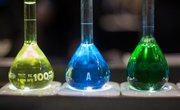
Chemical solutions have a concentration associated with them. The concentration allows you to know how much of a substance you are working with. Concentration is often reported in molarity (M), which is defined as mole of solute per liter solution (mol/L).
While molarity is usually a convenient way to talk about concentration, sometimes there aren't actually that many moles in the solution.
What does that mean? Well, say you have a 0.001 M solution of NaOH. It can be kind of annoying to say 0.001 M. Instead, scientists will move the decimal point to the right three places. This makes the new number 1. But the units are no longer moles/L, but rather millimoles/L or mmol/L. These units are called millimolar or mM.
While in many cases scientists prefer to talk about concentration in terms of molarity, it can sometimes be more useful to talk about mass per liter solvent. For example, this could be grams per liter (g/L) or milligrams/L (mg/L). Below, you will see an example as to why this is the case.
Given that there are so many different ways to talk about concentration, it is necessary to have a way to convert between them. Below you will see examples of how to convert from mmol/L to mg/L and visa versa.
Converting From mg/L to mmol/L
In order to convert from milligrams to mmol, you will need to make use of the molar mass of the substance in question. Since the molar mass is given in grams per mol (g/mol) you will also need to take into account that there is a conversion factor from milligrams to grams (there are 1,000 milligrams in 1 gram).
Take a look at the following example:
Say you have a 259 milligram per liter solution of NaOH (259 mg/L) and you want to see what the mmol/L or mM concentration is. You need to do some dimensional analysis given the fact that there are 1,000 milligrams in a gram and the molar mass of NaOH (39.997 g/mol).
First, convert the milligrams to grams:
Now, the units are g/L, and you can use the molar mass to convert to mol/L:
Finally, you can convert from moles to millimoles. There are 1,000 millimoles in 1 mole.
A one liter solution that contains 259 milligrams of NaOH is thus a 6.48 mM solution.
This entire dimensional analysis can be done in one step as well:
Thus, a 259 mg/L solution of NaOH is the same as a 6.48 mM solution of NaOH.
Converting From mmol/L to mg/L
Say you have a 10 mM solution of MgCl2. What is the concentration in mg/L? In other words, how many milligrams of the salt would you need to weigh out and add to a liter of solution?
First, begin by converting millimolar to molar:
Next, you can use the molar mass to find how many grams of MgCl2 there are in 0.010 moles or MgCl2.
Finally, you can convert the number of grams to milligrams:
This indicates that in a 10 mM solution of MgCl2 is the same as a 962 mg/L solution of MgCl2.
You can see why talking about the concentration in millimolar is a bit easier: It's a nice round number. On the other hand, the concentration of 962 mg/L tells you exactly how much salt to weigh out when making the solution.
This is a prime example of why knowing how to convert from mmol/L to mg/L (and visa versa) can be helpful in the lab.
References
About the Author
Riti Gupta holds a Honors Bachelors degree in Biochemistry from the University of Oregon and a PhD in biology from Johns Hopkins University. She has an interest in astrobiology and manned spaceflight. She has over 10 years of biology research experience in academia. She currently teaches classes in biochemistry, biology, biophysics, astrobiology, as well as high school AP Biology and Chemistry test prep.
Photo Credits
Hemera Technologies/AbleStock.com/Getty Images
